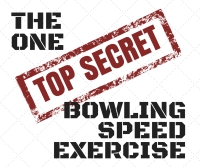|
 Your hips are the powerhouse of the bowling action: You have leapt to the crease, landed with a braced front leg and there is a surge of energy heading up your body like a pole vaulter's pole sends them over the bar. Your hips are the powerhouse of the bowling action: You have leapt to the crease, landed with a braced front leg and there is a surge of energy heading up your body like a pole vaulter's pole sends them over the bar.
But wait.
Before the energy can get into the ball to sear it down, it needs to get through your body. This is where your hips snap through with perfect timing. Coaches like Ian Pont call it hip drive. Every single super-fast bowler has it because it works.
Your hips are the first place to look if you are not bowling fast, and if you want to bowl faster. So, how do you learn to drive your hips effectively? It's a complex movement that involves the thighs, glutes, core and lats. It takes coordination and power.
The good news is that hip drive is a learned skill. You don't need to do naturally to be able to do it. If your hips are holding you back you can do some simple work to develop the ability to snap your hips.
Ultimate exercise for fast bowlers
To me that sounds very much like an old Russian exercise recently popularised in the west; the kettlebell swing.
Using this unusually shaped weight ("cannonball with a handle") you can perform a swing exercise that teaches you - guess what - a hip snap that looks remarkable like a fast bowler's hip drive. It teaches you the coordination you need to use all that ground force energy to put into the ball.
It also improves your overall power in just two 12 minute sessions a week. And the conditioning effect is perfect for when you want to build your endurance for longer spells, or you want to come back for a second spell just as fast as the first.
If you have no gym access and limited funds to buy kit, an investment in a kettlebell is the perfect answer.
What's not to love about that?
Get your hands on a kettlebell
There are different weights to choose from, and the best way to know is to try. Here is a simple guideline if you are unsure:
- Advanced men: 24kg
- Men: 16kg
- Advanced women: 12kg
- Women: 8kg
Younger athletes halve the recommended weights for adults (depending on age, size and strength).
You can get started right away and hone your technique as you go. Start with two times a week training two sets of 10 swings.
You can build this up gradually over time, adding more sets and reps as you get stronger and better at the movement. If you want to get more snap in your bowling, you can also do a couple of sets of 10-20 swings before you bowl. It's best to do this as close as possible to bowling time, on match day morning at least.
If you are using it for conditioning you will have more reps with a shorter rest time between sets. You are trying to get gassed (and leaving time to recover before a game). If you are using it for power, you have less sets and reps, a longer recovery time and your focus is on developing the hip snap power you can take to a game.
Be it power, conditioning or both, you can expect noticeable results within four weeks. Most people notice within two weeks. Your bowling will have more snap, you will become leaner and more focused as your fitness improves. Batsmen will be more hurried and you'll get the fast bowler's swagger of confidence.
There is no one way to use the swing to your advantage, as it depends on your needs and resources, but assuming you are a fast bowler playing cricket on Saturdays, your routine could look like this:
- Monday: Conditioning circuit: Kettlebell swings, push ups, chin ups, lunges and pallof press.
- Tuesday: Light mobility, no kettlebells
- Wednesday: Training, warm up with two sets of 10 swings
- Thursday: Power training: Five sets of 10 swings focusing on a powerful hip snap.
- Friday: Conditioning circuit: Kettlebell swings, push ups, chin ups, lunges and pallof press.
- Saturday: Morning power: three sets of 10 swings.
- Sunday: Rest and recovery
Proper weightlifters spend years honing their technique in exercises like cleans and snatches. The kettlebell has a big advantage: you have much less to learn to get similar results. You can use this as a low cost, simple and effective tool in your fast bowling toolbox.
Get a couple hidden somewhere at your ground and in your gym and watch your hips become super-explosive in less than a month.
Discuss this article with other subscribers
|

.jpg)
.jpg)


.jpg)
.jpg)
